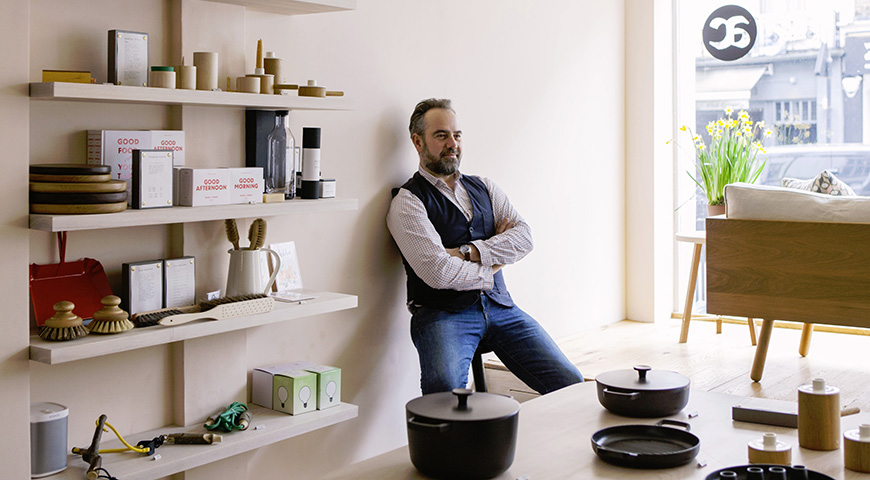Apologies for the long pause – I’ve been busy. But hey, you don’t pay subscription fees, so… (mutters inaudible comments under breath).
Ok. My current topic is often pondered. Small ‘start-up style’ design firms are edgy, nimble and free to pursue their passions without apology. But as they grow, gaining stakeholders, employees and advisors, the ship can become more cumbersome and difficult to steer. If they aren’t careful, the result can mean the design style they set out to deliver is watered down or lost in a world of spreadsheets and corporate compromise. From being quirky, coworking backpack-wearing indie underdogs, they then find themselves re-categorised as the mainstream default option, providing middle of the road design proposals rather than the leftfield style that once defined their brand.
Roger Stephenson OBE of Stephenson Studio (Manchester) has spent nearly four decades designing award winning architecture as founder / partner of several leading studios, whilst retaining his own progressive modernist approach. I asked him for his thoughts on big business versus small independents.

An interesting point. The growth of a business necessitates more supervisory roles, particularly for creative founders who may not excel at recruiting, teaching and supervising – and who may in fact be better placed at the drawing board with chunky bits of crayon and a Spotify playlist.
“I believe there is a limit to how far the developed culture can be stretched before the accumulated knowledge is spread so thinly as to be of no use.”
Roger continues “It is clear to observe; the bigger design firms get, the more they approach competent mediocrity. This result is only to be expected: design is very personality based, starting off with a few enthusiastic participants, a language develops as well as an underlying philosophy, resulting in the work of one studio being recognisable from that of another. This is not ‘house style’ but the results of a like-minded approach to problem solving. If successful, the group will grow. I believe there is a limit to how far the developed culture can be stretched before the accumulated knowledge is spread so thinly as to be of no use.”
As for the commercial challenges faced by Architecture firms large and small Roger adds, “I do not think there is any way to avoid the uncertainty of income which comes with the territory. I only know of 2 architects who have stayed small and controlled their workflow: Peter Zumthor and Glenn Murcutt, who have order books way into the future and tell people they can do their project if they are prepared to wait 3 years before they start…”
Eloquently put – and by a renowned Architect with a trophy cabinet that would make Sir Alex Ferguson shuffle with embarrassment. But in todays world of globalisation and mass production, does this theory apply to other related design sectors or is it unique to Architecture? Is it possible to scale up a craft furniture company for example to achieve its commercial ambitions, whilst staying true to its roots?
We head to Marylebone, London…


“This is both true from a commercial point of view, e.g. marketing, R&D, batch production, but also because relative lack of cash can slow down growth and can be a huge distraction. It also depends on whether the business is essentially a means to an end, i.e. a way for a maker to make and sell, or whether the end – growth and success – requires different means.”
Very true. The ambition and drive of the business founder is a key pace setter that may ultimately define its very DNA. As companies evolve, their experience grows and they learn to respond to changes in the marketplace. The first phase is to establish, survive and turn a profit. Once these boxes are ticked, an increase in appetite often follows and the next stage beckons.
So where does that put Another Country after six successful years? “We have come through that initial (not always relaxing!) startup / launch phase and I would say we were ready for the next one.” enthuses Paul.
But will an acceleration in commercial growth not potentially jeopardise ‘craft appeal’? Are the two mutually exclusive, I ask?
“If the founders remain in charge then the vision can be maintained. If, however commercial imperatives completely supersede brand / creative ones then you run the risk of losing that identity.”

“…there is also great value in doing things well and more efficiently on a larger scale…”
“The matter of small, craft handmade is exactly the point that one shouldn’t romanticise.” Paul continues, “One cannot make a difference and do good on a larger scale by only making things by hand. It (handmade) needs preserving… and plays an important role in the overall chain of production, but there is also great value in doing things well and more efficiently on a larger scale. I would hesitate to move production to Asia and toss sustainability to the wayside for example, but would instead scale up to bigger manageable batches with a short EU based supply chain and excellent quality control. Retaining tight control over the scale of production also allows you to stay more creative and not take huge commercial risks when introducing new designs.”
Could it be that for furniture companies, cleverly managed growth, effective use of modern production methods and firm grip on quality and founding principles could actually promote creativity and design freedom rather than stifling it? Hmmm….
Part two of this article will be out shortly, with insight from a leading UK interior designer, plus opinion from a fast moving British furniture company making big ripples on the other side of the pond. Design versus big business: Can you have it all…?











